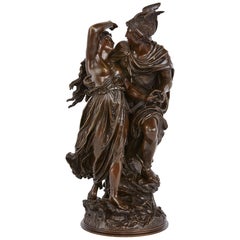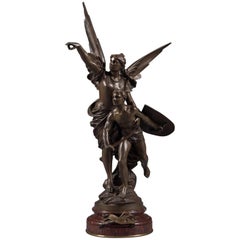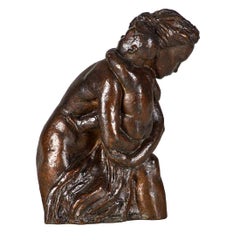L. Gregoire Sculptures
to
1
1
1
1
1
1
1
Height
to
Width
to
1
1
1
1
366
260
240
198
Creator: L. Gregoire
Patinated Bronze Antique Sculptural Group of Andromeda and Perseus by Grégoire
By L. Gregoire 1
Located in London, GB
This fine antique French sculpture depicts a moment from one of the most famous tales from Classical mythology, that of Perseus and Andromeda....
Category
19th Century French Classical Greek Antique L. Gregoire Sculptures
Materials
Bronze
Related Items
Fine French Patinated Bronze Figural Group Titled Pro Patria by Edouard Drouot
By Edouard Drouot
Located in Tarzana, CA
A very fine French antique patinated bronze figural group titled Pro Patria by Edouard Drouot
(French, 1859-1945) late 19th century.
Depicting a figure of winged Victory with a ...
Category
Late 19th Century French Late Victorian Antique L. Gregoire Sculptures
Materials
Bronze
$16,250
H 30 in W 18 in D 9 in
Cast Patinated Bronze of Mother and Child
Located in Montreal, QC
Cast patinated bronze of mother and child. Signature ineligible.
Category
1970s Vintage L. Gregoire Sculptures
Materials
Bronze
French 19th C Gilt and Patinated Bronze Group of Gloria Victis, by A. Mercie
By F. Barbedienne Foundry, Antonin Mercie
Located in New York, NY
An Incredible and Large Gilt and Patinated Bronze Group of Gloria Victis, a Winged Figure of Victory with a Fallen Warrior. This incredible bronze piece was cast after a model by Maarius-Jean-Antonin Mercié, This model is signed 'F. BARBEDIENNE FONDEUR PARIS' demonstrating that it was cast by Ferdinand Barbedienne's foundry, the best bronzier of the 19th century. The base is further signed 'A. Mercie' and stamped 'Réduction Mécanique' with an inscription of '659'. The figure is mounted on a Belgian noir marble base with various stepped edges. Gloria Victis is one the most well-known and important bronze casts of the 19th Century. The quality of this particular model is absolutely incredible and all the marking indicate that this particular piece is one of the finest produced by the Foundry.
A student of Jouffroy and de Falguière at the Ecole des Beaux-Arts, Marius-Jean-Antonin Mercié (1845-1916) won the Grand Prix de Rome at 23 years old with his work Thésée vainqueur du Minotaure. In 1872, he sent the plaster model of his work David vainqueur to the Salon, for which he won the first class medal. At the same time, he received La croix de la Légion d'honneur at the Villa Medici. His return to Paris, in 1874, issued in a long and brilliant career with numerous commissions, notably the monuments for Louis-Philippe and Queen Marie-Amélie for the Royal Chapel at Dreux (1886).
By the age of 30 Mercié was already very well-known and his Gloria Victis received resounding success when it was exhibited at the Salon, in 1874 (in plaster) and in 1875 (in bronze). This work exalted the heroism and the patriotic sentiments aroused by the disasters of 1870. His predilection for patriotic subjects is shown in many of his works such as Quand même...
Category
19th Century French Louis XVI Antique L. Gregoire Sculptures
Materials
Belgian Black Marble, Bronze
$29,726
H 31.5 in W 9.5 in D 8 in
Bronze Group "Perseus And Andromeda" By Jean-Louis Gregoire
By Jean Louis Grégoire
Located in Norwood, NJ
19th century French bronze sculpture "Perseus Freeing Andromeda" by Jean-Louis Grégoire (French, 1840-1890). Signed on base L Grgoire.
Subject matter is "Perseus and Andromeda...
Category
Late 19th Century French Antique L. Gregoire Sculptures
Materials
Bronze
19th Century French Bronze Group of Nessus Abducting Deianira
By Giambologna
Located in Dublin, IE
French Grand Tour bronze group of Nessus abducting Deianira after Giambologna on marble base.
After the model by Giambologna
Circa 1880
French
Footnote:
The first documented example of this famous bronze group was made by Giovanni Bologna...
Category
19th Century French Classical Greek Antique L. Gregoire Sculptures
Materials
Marble, Bronze
$13,350
H 25.99 in W 18.12 in D 13.19 in
19th Century Gilded Bronze Sculptural Group
Located in Madrid, ES
This elegant 19th-century gilded bronze sculptural group is a stunning piece of art. It is mounted on white Carrara marble, which enhances its overall beauty and grandeur. The sculpt...
Category
Early 1900s Antique L. Gregoire Sculptures
Materials
Bronze
A Continental 19th century Bronze and Marble statue of Perseus and Medusa
Located in West Palm Beach, FL
An exceptional Continental 19th century Grand Tour Period patinated Bronze, Black Belgian, and Rosso Alicante marble statue of Perseus and Medusa. This handsome statue of Perseus hav...
Category
19th Century Unknown Grand Tour Antique L. Gregoire Sculptures
Materials
Marble, Bronze
$10,780
H 20.5 in W 6.5 in D 4.75 in
Patinated Bronze Figural Group of Diana the Huntress and Her Hound, circa 1925
Located in New York, NY
Inscribed Ary Bitter (1883-1973) with The L.N. and J.L. Foundry, Paris.
Category
1920s French Vintage L. Gregoire Sculptures
Materials
Bronze
$37,500
H 26.5 in Dm 9 in
Patinated Bronze Sculpture of a Deer by Hagenauer
By Karl Hagenauer
Located in Pittsburgh, PA
This whimsical sculpture of a stag is from the famed Werkstatte Hagenauer Wien.
Category
Mid-20th Century Austrian Mid-Century Modern L. Gregoire Sculptures
Materials
Bronze
A silver plated bronze sculptural group of a Cockerel By Christofle
Located in London, GB
This silver plated bronze sculptural group of a Cockerel and a chicken an a gilt-bronze mounted hard-stone base was made in Circa 1890 by Christofle
Category
19th Century Antique L. Gregoire Sculptures
Materials
Silver Plate
$5,191
H 8.67 in W 6.3 in D 4.73 in
French Patinated Bronze Group of a Figure and Donkey, Entitled Anier Du Caire
Located in London, GB
Cast by Pinèdo from a model by Antoine Bofill, late 19th century, Signed 'A. Bofill' and 'BRONZE GARANTI' stamp.
Category
Late 19th Century French Antique L. Gregoire Sculptures
Materials
Bronze
$9,289
H 17.72 in W 16.93 in D 6.7 in
French Antique Patinated Bronze Bust of an Elegant Woman
Located in LA CIOTAT, FR
Antique Elegance with an Art Nouveau Twist !
Embrance the timeless beauty of the 19th century French School with this exquisite Art Nouveau bust sculpture. A captivating bust of a w...
Category
19th Century Unknown Art Nouveau Antique L. Gregoire Sculptures
Materials
Bronze
L. Gregoire sculptures for sale on 1stDibs.
L. Gregoire sculptures are available for sale on 1stDibs. These distinctive items are frequently made of metal and are designed with extraordinary care. There are many options to choose from in our collection of L. Gregoire sculptures, although gold editions of this piece are particularly popular. If you’re looking for additional options, many customers also consider sculptures by and August Moreau. Prices for L. Gregoire sculptures can differ depending upon size, time period and other attributes — on 1stDibs, these items begin at $2,495 and can go as high as $11,991, while a piece like these, on average, fetch $7,243.


